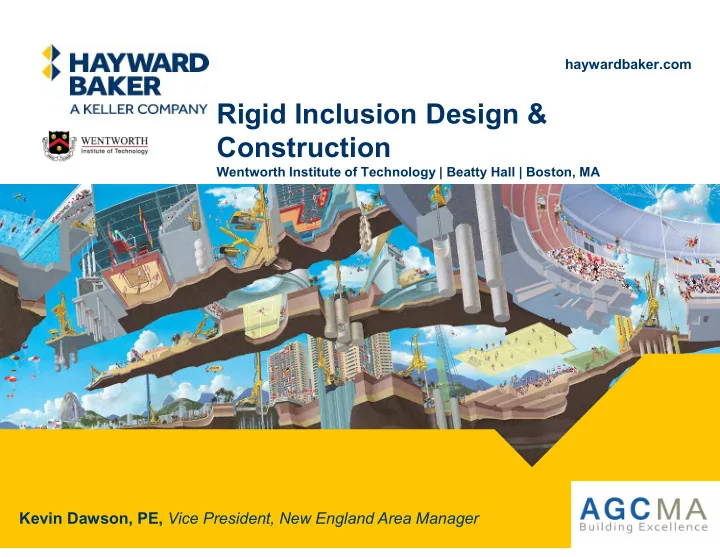

haywardbaker.com Rigid Inclusion Design & Construction Wentworth Institute of Technology | Beatty Hall | Boston, MA Kevin Dawson, PE, Vice President, New England Area Manager
Presentation Outline � Why Rigid Inclusions � What are Rigid Inclusions � Common Applications � Design Overview � Quality Control � Questions 116
Why Rigid Inclusions? • Geotechnical −Reduce Settlement −Increase Bearing Capacity • Structural −Shallow Spread Footing −Slab-on-grade replaces structural slab • Environmental −Little to no spoil (contamination) −Quiet compared to pile driving 117
Benefits Cost: Shallow spread foundations and slab-on-grade vs. pile caps and structural slab Schedule: Gain time compared to surcharge or surcharge with wick drains Reduce settlement more than aggregate piers Minimizes spoil created at ground surface Quality verification through data acquisition and testing 118
What are Rigid Inclusions (RI)? • High modulus grout columns • Typical diameters 12” to 18” • Works in conjunction with a load transfer platform (LTP) • Less compressible than an aggregate pier or stone column 119
Installation Tool is driven/drilled to bearing layer. Displace soil � minimal spoil generated Refusal based on design and feedback from installation process Grout is backfilled into cavity while extracting the tool. 120
RI System Installation Overview 1. Working platform preparation and control (Safety) 2. RIs are installed using drilling or vibratory methods 3. RI heads are lowered (as needed) 4. Load transfer platform (LTP) is installed per design (1) (2) (3) (4) 121
Typical RI Installation 122
Geologic Conditions 3 1 2 123
Applications: Foundation Support 124
Applications: MSE Walls 125
Applications: Warehouses 126
Quantifying Benefits 1700 psf 20-30 ft Estimated settlement without ground improvement – 6 inches Estimated settlement with aggregate piers – 1.5 to 3 inches Estimated settlement with rigid inclusions – less than 1 inch 127
Finite Element – Axisymmetric/Unit Cell Behavior of a single RI that is part of an infinite grid of RIs Load-displacement – Designer must account for the relative movement between the RI tip and the adjacent soil and the relative movement between the RI head and the LTP 128
Load Transfer Platform � A load transfer platform (LTP) is used to transfer load from the structure to the Rigid Inclusions � Structural Fill – Granular soil (VDOT 21B) � LTPs may include 1 to 3 layers of embedded geogrid or steel mesh 129
Load Transfer Platform � A load transfer platform (LTP) is used to transfer load from the structure to the Rigid Inclusions � Structural Fill – Granular soil (VDOT 21B) � LTPs may include 1 to 3 layers of embedded geogrid or steel mesh 130
HBI Data Acquisition System (DAQ) 131
HBI Data Acquisition System (DAQ) 132
RI Load Testing � Static Load Testing � 150% to 200% Design load � Design load from Finite Element Analysis 133
Thank You!! Questions? 134
Recommend
More recommend